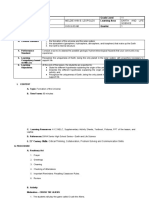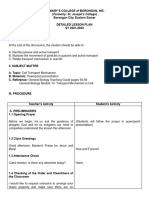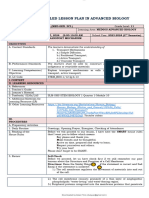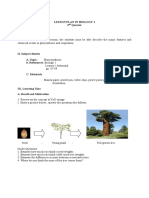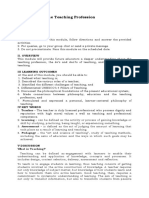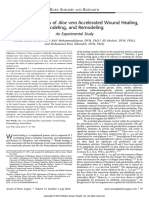General Biology 1 First Quarter
General Biology 1 First Quarter
Uploaded by
Anjhiene CambaCopyright:
Available Formats
General Biology 1 First Quarter
General Biology 1 First Quarter
Uploaded by
Anjhiene CambaOriginal Title
Copyright
Available Formats
Share this document
Did you find this document useful?
Is this content inappropriate?
Copyright:
Available Formats
General Biology 1 First Quarter
General Biology 1 First Quarter
Uploaded by
Anjhiene CambaCopyright:
Available Formats
Republic of the Philippines
Department of Education
Region I
SCHOOLS DIVISION OF ALAMINOS
c ALAMINOS CITY NATIONAL HIGH SC
Alaminos City, Pangasinan
GENERAL BIOLOGY 1
FIRST QUARTER
Performance Standard
Content Standard
The learners demonstrate
understanding of …
1. Cell Theory The
1. construct a 3Dlearners …
model of a plant/animal/bacterial cell
using recyclable materials
2. Cell Structure and Functions
3. Prokaryotic vs Eukaryotic Cells
4. Cell Types
5. Cell Modifications
6. Cell Cycle Construct a cell membrane model from
a. Mitosis indigenous or recyclable materials
b. Meiosis
Structures and Functions of Biological
Molecules
-Enzymes
Republic of the Philippines
Department of Education
Region I
SCHOOLS DIVISION OF ALAMINOS CITY
LAMINOS CITY NATIONAL HIGH SCHOOL
Alaminos City, Pangasinan
GENERAL BIOLOGY 1
FIRST QUARTER
Most Essential Learning Competencies Duration
Explain the postulates of the cell theory
Week 1
Describe the structure and function of major and
subcellular organelles
Distinguish prokaryotic and eukaryotic cells
according to their distinguishing features
Week 2
Classify different cell types (of plant/animal
tissues) and specify the functions of each
Describe some cell modifications that lead to
adaptation to carry out specialized functions (e.g.,
microvilli, root hair) STEM_BIO11/12-la-c-5
Week 3
Characterize the phases of the cell cycle and their
control points. STEM_BIO11/12-ld-f-6
Describe the stages of mitosis/meiosis given 2n=6
STEM_BIO11/12-Id-f-7
Week 4
Explain the significance or applications of
mitosis/meiosis STEM_BIO11/12-Id-f-9
Week 4
Explain the significance or applications of
mitosis/meiosis STEM_BIO11/12-Id-f-9
Identify disorders and diseases that result from the
malfunction of the cell during
the cell cycle STEM_BIO11/12-Id-f10
Week 5
Describe the structural components of the cell
membrane STEM_BIO11/12-Ig-h-11
Relate the structure and composition of the cell
membrane to its function STEM_BIO11/12-Ig-h-12
Explain the transport mechanism in cells (
diffusion osmosis, facilitated transport, active
transport) STEM_BIO11/12-Ig-h-13
Week 6
Differentiate exocytosis and endocytosis
STEM_BIO11/12-Ig-h-14
Describe the components of enzyme
STEM_BIO11/12-Ii-j-17
Explain oxidation/reduction reactions
STEM_BIO11/12-Ii-j-18
Week 7
Determine how factos such as pH, temperature,
and substrate affect enzyme activity
STEM_BIO11/12-Ii-j-19
Unpacked Objectives
Identify the contributions of the ff. scientist in
the cell theory:
a. Robert Hooke
b. Antonie van
Leeuwenhoek
c. Theodor Schwann
d. Matthias Schleiden
e.
Robert Remak
f. Rudolf Virchow
Explain the 3 postulates of cell theory.
Describe the structure and function of major
organelles:
a. nucleus
b. mitochondria
c. chloroplast
d. cell membrane
e. cytosol
f. ribosome
g. lysosome
Describe the structure and function of
subcellular organelles:
a. cell wall
b. vacuole
c. cytoskeleton
d. peroxisome
e. golgi bodies
f. endoplasmic
reticulum
Compare and contrast eukaryotic and
prokaryotic cells.
Classify different cell types of animal tissue
and specify the function of each
a. blood cells
b. stem cells
d. nerve cells
e. muscle cell
f. bone cells
g. skin cells
h.
sex cells
Classify different cell types of plants and
specify the functions of each
a. parenchyma cells
b. collenchyma cells
c. sclerenchyma cells
Identify cell modifications and describe their
respective functions.
a. Cilia
b. flagella
c. pili
d. microvilli
e. root hair
f. dendrite and axon
g. actin and
myosin
Identify and differentiate the phases of the
cell cycle
a. Interphase
b. Mitotic phase
Describe the regulation of the cell cycle at
internal checkpoints
a. G1 checkpoint
b. G2 checkpoint
c. M checkpoint
Describe the positive and negative regulations
Describe the different stages of mitosis.
Identify the major event/s in each stage.
Illustrate each stage.
Describe the different stages of meiosis.
Identify the major event/s in each stage.
Illustrate each stage.
Explain the significance and applications of
mitosis
Explain the significance and applications of
meiosis
Identify the different disorders and diseases
caused by the errors in the cell cycle.
a.
aneuploidy
b. mosaicism
c. cancer
Explain how these
disorders/diseases exist .
Describe the features
if these disorders/diseases.
Describe the following structural components
of the cell membrane:
a. protein (Integral and Peripheral protein)
b.
lipids (Phospholipids and Cholesterol)
c. carbohydrates
Explain the function of the structural
components of the cell membrane.
Discuss how the structures work with one
another.
Differentiate Active and Passive transport
Describe the process of
osmosis Identify examples of
these transport mechanisms
Explain facilitated diffusion
Give examples of this transport mechanism
Differentiate the process of endocytosis and
exocytosis
Describe the 3 types of endocytosis I
Describe the structure of enzyme
Explain the classification of enzyme
Explain the enzymes mechanism of action
Differentiate the process of reduction and
oxidation
Give examples of events that involve
these processes
Explain how the following factors affect the
ezyme activity:
a. environmental conditions
*optimum temperature
*pH
*substrate
concentration and reaction rate
b. co-
factors and coenzyme
c. enzyme inhibitors
Write the most common and Least common answers of students for the following items:
Description of COVID-19
Possible signs and symptoms of COVID-19
Health measures of avoiding COVID-19
Changes in the community/school brought by COVID-19 pandemic
Feelings/emotions experienced during the crisis situation
reasons why they felt those emotions (most common emotion and least Common)
How does knowing
You might also like
- Sysmex XN Series XN-1000 Instruction For Use May 2014-EnglishDocument434 pagesSysmex XN Series XN-1000 Instruction For Use May 2014-Englishpiexz77% (52)
- NUR3111 Post-Lecture QuizDocument28 pagesNUR3111 Post-Lecture QuizliNo ratings yet
- Q3 WEEK 3 LAS-1-Reproductive IsolationDocument1 pageQ3 WEEK 3 LAS-1-Reproductive IsolationAnjhiene CambaNo ratings yet
- General Biology 2: Quarter 3: Module 4Document4 pagesGeneral Biology 2: Quarter 3: Module 4Ann Lorraine Montealto Sadora100% (1)
- Science, Technology, and SocietyDocument27 pagesScience, Technology, and SocietyAnjhiene CambaNo ratings yet
- The Learners Demonstrate Understandin G Of... The Learners Should Be Able To..Document3 pagesThe Learners Demonstrate Understandin G Of... The Learners Should Be Able To..Sab Ibarreta100% (2)
- General Biology 1 Lesson Plan Week 1Document4 pagesGeneral Biology 1 Lesson Plan Week 1Mark Vincent ValenciaNo ratings yet
- Semi DetailedDocument6 pagesSemi DetailedMeldie Ann B. LeopoldoNo ratings yet
- Gen Bio Week 8Document2 pagesGen Bio Week 8alvinPabores100% (1)
- Chemical and Nervous Control Part 1 T.GDocument5 pagesChemical and Nervous Control Part 1 T.GMarichu Cayabyab100% (2)
- DDL in Gen Bio With AnnotationsDocument8 pagesDDL in Gen Bio With AnnotationsEarl Caesar Quiba Pagunsan100% (1)
- Final DLPDocument8 pagesFinal DLPRiena PaladaNo ratings yet
- 7es Lesson PlanDocument5 pages7es Lesson PlanCath ReenNo ratings yet
- FIDP Life ScienceDocument6 pagesFIDP Life ScienceLorin XDNo ratings yet
- WHLP Gen Bio 1 Week 5Document2 pagesWHLP Gen Bio 1 Week 5Marianne GonzalesNo ratings yet
- Q3 Q4 LEAST LEARNED Physical ScienceDocument2 pagesQ3 Q4 LEAST LEARNED Physical ScienceJoy AlcantaraNo ratings yet
- Table of Specifications Gen. Bio 1: Cell Theory Cell Cell Structure and FunctionsDocument2 pagesTable of Specifications Gen. Bio 1: Cell Theory Cell Cell Structure and FunctionsRosana De AsisNo ratings yet
- LC 63Document3 pagesLC 63JT SaguinNo ratings yet
- DLP Racel AsuncionDocument3 pagesDLP Racel Asuncionshermaine genistonNo ratings yet
- My Daily Lesson Plan in General Biology.Document14 pagesMy Daily Lesson Plan in General Biology.angel Marcos100% (1)
- DLP April 3 GenBio2Document2 pagesDLP April 3 GenBio2sherlockdrnNo ratings yet
- 1 DLL Gen BioDocument3 pages1 DLL Gen BioGretchenNo ratings yet
- Genetic Engineering Lesson PlanDocument4 pagesGenetic Engineering Lesson PlanJESICA OXALESNo ratings yet
- Grade 11 Physical Science Course of StudyDocument3 pagesGrade 11 Physical Science Course of StudyJobeth Presto AlonzoNo ratings yet
- Simplified Teaching Guide Earth SystemsDocument4 pagesSimplified Teaching Guide Earth SystemsJordan EspirituNo ratings yet
- Senior High School InterviewDocument4 pagesSenior High School InterviewMikMikNo ratings yet
- PERFORMANCE TASK FOR SCIENCE 9 PoDocument4 pagesPERFORMANCE TASK FOR SCIENCE 9 PoMarianne SerranoNo ratings yet
- Week 6 (Earth Science)Document10 pagesWeek 6 (Earth Science)wendel junioNo ratings yet
- Exemplar Science Lesson Plan For Senior High School General Biology 1Document4 pagesExemplar Science Lesson Plan For Senior High School General Biology 1LG NiegasNo ratings yet
- Daily Lesson LOG: Monday Tuesday Wednesday Thursday FridayDocument5 pagesDaily Lesson LOG: Monday Tuesday Wednesday Thursday FridayJeffrey YumangNo ratings yet
- DLL Shs Stem Grade 12general Biology1 Quarter1 Week1 Palawan Division 1 PDF FreeDocument13 pagesDLL Shs Stem Grade 12general Biology1 Quarter1 Week1 Palawan Division 1 PDF FreeJinky AydallaNo ratings yet
- Tos Genbio2Document1 pageTos Genbio2MICHAEL-JEFF GAGABE100% (1)
- Leyte National High School: GRADE 11 (Academic Track/STEM Strand)Document1 pageLeyte National High School: GRADE 11 (Academic Track/STEM Strand)John Erniest Tabungar AustriaNo ratings yet
- SHSCOTDocument3 pagesSHSCOTJassy Christine CalacatNo ratings yet
- 2.1 Energy Flow in EcosystemDocument1 page2.1 Energy Flow in Ecosystempeisuanyap100% (1)
- Stem Cell Lesson PlanDocument3 pagesStem Cell Lesson Planapi-498288322No ratings yet
- Earth and Life Science: Lesson PlanDocument21 pagesEarth and Life Science: Lesson PlanBorbe ClauNo ratings yet
- Module 12 Physical ScienceDocument6 pagesModule 12 Physical ScienceElixa HernandezNo ratings yet
- Earth and Life Science MELCsDocument4 pagesEarth and Life Science MELCsValiant TiaciNo ratings yet
- Detailed Lesson Plan (DIFFERENT TYPES OF VOLCANIC ERUPTION)Document5 pagesDetailed Lesson Plan (DIFFERENT TYPES OF VOLCANIC ERUPTION)ncplmrsNo ratings yet
- Daily Lesson LogDocument6 pagesDaily Lesson LogmyleneNo ratings yet
- Bio 2Document49 pagesBio 2Rey EncisoNo ratings yet
- At The End of This Cell Theory Lesson PlanDocument5 pagesAt The End of This Cell Theory Lesson PlanJohn Carl Angelo EstrellaNo ratings yet
- Earth ScienceDocument17 pagesEarth ScienceJerry De Leon TaayNo ratings yet
- ATG Earth Science Lesson 4Document5 pagesATG Earth Science Lesson 4Richard PascuaNo ratings yet
- Process Skills - Based Instructional Materials Towards An Enhanced Students Performance in Science 7 (Physics)Document12 pagesProcess Skills - Based Instructional Materials Towards An Enhanced Students Performance in Science 7 (Physics)Psychology and Education: A Multidisciplinary Journal100% (1)
- Semi-Detailed Lesson Plan Cell Membrane and Transport MechamismDocument3 pagesSemi-Detailed Lesson Plan Cell Membrane and Transport MechamismAileen TorioNo ratings yet
- Earth AND Life Science: Worksheet/S On Genetic Engineering and Animal Organ SystemDocument8 pagesEarth AND Life Science: Worksheet/S On Genetic Engineering and Animal Organ SystemBei CabNo ratings yet
- Gen Bio 2 Midterms Week 3 PPT Central Dogma of Molecular BiologyDocument62 pagesGen Bio 2 Midterms Week 3 PPT Central Dogma of Molecular BiologyROGELIO COLUMNANo ratings yet
- Biology 2, July 3, 2019Document2 pagesBiology 2, July 3, 2019Lagoy Zyra MaeNo ratings yet
- Lesson Plan in Biology 1 2 QuarterDocument3 pagesLesson Plan in Biology 1 2 QuarterLieshaNo ratings yet
- Oscillating Universe TheoryDocument1 pageOscillating Universe TheoryArabella BasilioNo ratings yet
- Naguilian Senior High School: Weekly Home Learning Plan Earth and Life Science SCHOOL YEAR 2020-2021Document2 pagesNaguilian Senior High School: Weekly Home Learning Plan Earth and Life Science SCHOOL YEAR 2020-2021nicky tampocNo ratings yet
- Parents/guardian Will Get The SLM That Is Good For 6 Weeks in The Assigned Area by Purok On Monday October 5, 2020 at 7:30-8:30am andDocument3 pagesParents/guardian Will Get The SLM That Is Good For 6 Weeks in The Assigned Area by Purok On Monday October 5, 2020 at 7:30-8:30am andMarianne GonzalesNo ratings yet
- L 7-8 Periodic Variations in Atomic PropertiesDocument15 pagesL 7-8 Periodic Variations in Atomic PropertiesアゼロスレイゼルNo ratings yet
- Daily Lesson Plan in Earth and Life Science I. Objectives: (S11/12Lt-Ivfg-64)Document3 pagesDaily Lesson Plan in Earth and Life Science I. Objectives: (S11/12Lt-Ivfg-64)JT SaguinNo ratings yet
- F. Moreno, Rachel Anne Melc 4 Activity 3 Calvin CycleDocument3 pagesF. Moreno, Rachel Anne Melc 4 Activity 3 Calvin CycleF. Moreno, Rachel AnneNo ratings yet
- Stem - Bio11 /12-La-C-5: Wake Up, Eat Breakfast and Get Ready For The Scheduled LessonsDocument2 pagesStem - Bio11 /12-La-C-5: Wake Up, Eat Breakfast and Get Ready For The Scheduled LessonsMarianne GonzalesNo ratings yet
- C S N H S: Agaytay Ity Cience Ational Igh ChoolDocument5 pagesC S N H S: Agaytay Ity Cience Ational Igh ChoolAndrea Celina Dinglasan100% (1)
- Structures and Functions of Major Subcellular Organelles DLPDocument2 pagesStructures and Functions of Major Subcellular Organelles DLPBlessie Alisasis DequinaNo ratings yet
- Lesson Plan in Grade 12-STEM 2022 1Document2 pagesLesson Plan in Grade 12-STEM 2022 1Jessa Rey Peñafiel100% (1)
- General Biology 1 Self-Learning Packet Preliminaries Module #3-Structure Components of The Cell MembraneDocument9 pagesGeneral Biology 1 Self-Learning Packet Preliminaries Module #3-Structure Components of The Cell MembraneGi GiNo ratings yet
- Ucture and Composition of Cell Membrane To Its FunctionsDocument21 pagesUcture and Composition of Cell Membrane To Its FunctionsCamille Darcy AguilarNo ratings yet
- DLL Cell Cycle and Cell DivisionDocument2 pagesDLL Cell Cycle and Cell DivisionRei-Rei Ramos0% (1)
- Gen Bio1 Module 9Document23 pagesGen Bio1 Module 9Anjhiene Camba100% (2)
- General Biology I M6Document19 pagesGeneral Biology I M6Anjhiene Camba50% (2)
- Gen Bio1 - Module 13Document19 pagesGen Bio1 - Module 13Anjhiene CambaNo ratings yet
- General Biology I M7Document19 pagesGeneral Biology I M7Anjhiene CambaNo ratings yet
- Gen Bio1 Module 10Document20 pagesGen Bio1 Module 10Anjhiene CambaNo ratings yet
- Q3 - WEEK 8 - LAS-2-Cladistics-Shared Derived CharacterDocument2 pagesQ3 - WEEK 8 - LAS-2-Cladistics-Shared Derived CharacterAnjhiene CambaNo ratings yet
- General Biology I M4Document24 pagesGeneral Biology I M4Anjhiene CambaNo ratings yet
- Q3 - WEEK 7 - LAS-2-Classification of Organism Using Hierarchal SystemDocument2 pagesQ3 - WEEK 7 - LAS-2-Classification of Organism Using Hierarchal SystemAnjhiene CambaNo ratings yet
- Q3 - WEEK 3 - LAS-3-Timeline of Evolution ThoughtDocument1 pageQ3 - WEEK 3 - LAS-3-Timeline of Evolution ThoughtAnjhiene CambaNo ratings yet
- Q3 - WEEK 8 - LAS-3-Cladogram-Infer Evolutionary RelatednessDocument1 pageQ3 - WEEK 8 - LAS-3-Cladogram-Infer Evolutionary RelatednessAnjhiene CambaNo ratings yet
- Q3 - WEEK 3 - LAS-2-SpeciationDocument1 pageQ3 - WEEK 3 - LAS-2-SpeciationAnjhiene CambaNo ratings yet
- Q3 - WEEK 7 - LAS-3-Dichotomous Keys For IdentificationDocument1 pageQ3 - WEEK 7 - LAS-3-Dichotomous Keys For IdentificationAnjhiene CambaNo ratings yet
- Q3 - WEEK 2 - LAS-3-Mechanism-of-change-in-populationsDocument2 pagesQ3 - WEEK 2 - LAS-3-Mechanism-of-change-in-populationsAnjhiene CambaNo ratings yet
- Q3 - WEEK 6 - LAS-1-Multiple Lines of EvidenceDocument2 pagesQ3 - WEEK 6 - LAS-1-Multiple Lines of EvidenceAnjhiene CambaNo ratings yet
- Q3 - WEEK 5 - LAS-3-Infering Relationships From Evidences of Evolution-FossilsDocument2 pagesQ3 - WEEK 5 - LAS-3-Infering Relationships From Evidences of Evolution-FossilsAnjhiene CambaNo ratings yet
- Teaching Profession Module 1Document15 pagesTeaching Profession Module 1Anjhiene CambaNo ratings yet
- Gen Bio Quiz 3Document3 pagesGen Bio Quiz 3Anjhiene CambaNo ratings yet
- Letter of Application GPC 1111111Document4 pagesLetter of Application GPC 1111111Anjhiene CambaNo ratings yet
- Social Dimensions Module 1Document14 pagesSocial Dimensions Module 1Anjhiene CambaNo ratings yet
- Assessment of Student Learning Ii: Beed Module 2Document7 pagesAssessment of Student Learning Ii: Beed Module 2Anjhiene CambaNo ratings yet
- Semi-Detailed Lesson Plan in Physical Science: Schools Division of Alaminos CityDocument27 pagesSemi-Detailed Lesson Plan in Physical Science: Schools Division of Alaminos CityAnjhiene CambaNo ratings yet
- Teaching Arts in The Elemntary Module 1Document31 pagesTeaching Arts in The Elemntary Module 1Anjhiene Camba100% (1)
- PDF Module 2Document8 pagesPDF Module 2Anjhiene CambaNo ratings yet
- Lecture MotivationDocument15 pagesLecture MotivationfowsblogNo ratings yet
- G's Pharyngeal Arches Embrology 9Document127 pagesG's Pharyngeal Arches Embrology 9Ajay PrashanthNo ratings yet
- Grade 9 Science: Self Learning Module (SLM)Document11 pagesGrade 9 Science: Self Learning Module (SLM)MariedelSindayenDelfinadoNo ratings yet
- Ant PDFDocument36 pagesAnt PDFNuman Al BakirNo ratings yet
- Silent Sound Technology: AbstractDocument3 pagesSilent Sound Technology: AbstractMegha MaturNo ratings yet
- The Cell Structure: Worksheet No. 2 Name Angel Rose R. Rico Course/Year/Block BSFT-2ADocument4 pagesThe Cell Structure: Worksheet No. 2 Name Angel Rose R. Rico Course/Year/Block BSFT-2Arosecel jayson ricoNo ratings yet
- Enzyme KineticsDocument23 pagesEnzyme Kinetics1DS19CH011 Jashwanth C RNo ratings yet
- Human Anatomy - Module 1 & 2 - Final TermDocument46 pagesHuman Anatomy - Module 1 & 2 - Final TermwelpNo ratings yet
- General Biology - Q2 - Week 5Document14 pagesGeneral Biology - Q2 - Week 5Renard Jaen100% (1)
- Waec Biology ExampulseDocument82 pagesWaec Biology ExampulsealbertayomideakiodeNo ratings yet
- ListeningDocument9 pagesListeningNguyệt Lê Thị ÁnhNo ratings yet
- Current Trends in The Biokinetic Analysis of The Foot and AnkleDocument6 pagesCurrent Trends in The Biokinetic Analysis of The Foot and AnkleCarlos gutierrezNo ratings yet
- Energy and Ecosystems Part 2Document16 pagesEnergy and Ecosystems Part 2dfq67gtkqs100% (1)
- Pathological Postpartum Breast Engorgement Prediction, Prevention, and ResolutionDocument6 pagesPathological Postpartum Breast Engorgement Prediction, Prevention, and ResolutionHENINo ratings yet
- Classification of OrganismsDocument10 pagesClassification of Organismsprince matamboNo ratings yet
- General AnatomyDocument76 pagesGeneral AnatomyDinith ChathurangaNo ratings yet
- Module 4 Notes (Psych 101)Document3 pagesModule 4 Notes (Psych 101)christianallenmlagosNo ratings yet
- 7C Muscles and BonesDocument1 page7C Muscles and BonesIan MartinNo ratings yet
- Maintain Homeostasis With Negative Feedback LoopDocument3 pagesMaintain Homeostasis With Negative Feedback Loopnndkasnd sdfoashdfNo ratings yet
- The Language of AnatomyDocument15 pagesThe Language of AnatomyClemcy Pearl MonisNo ratings yet
- C1.1 Enzymes and MetabolismDocument16 pagesC1.1 Enzymes and MetabolismsangosakaNo ratings yet
- To His Coy Mistress Line by Line ExplanationDocument6 pagesTo His Coy Mistress Line by Line ExplanationJahangir AlamNo ratings yet
- General Surgery MCQDocument190 pagesGeneral Surgery MCQلمسة مصمم100% (1)
- Evolution of Aortic Arches in VertebratesDocument2 pagesEvolution of Aortic Arches in Vertebratesarbazkhan825lNo ratings yet
- Cambridge International Advanced Subsidiary and Advanced LevelDocument16 pagesCambridge International Advanced Subsidiary and Advanced LevelAlfredo MartinNo ratings yet
- Mempot Practical 2024 StudentDocument19 pagesMempot Practical 2024 Studentkambojarsh398No ratings yet
- Topical Application of Aloe Vera Accelerated Wound Healing, Modeling, and RemodelingDocument10 pagesTopical Application of Aloe Vera Accelerated Wound Healing, Modeling, and RemodelingenviNo ratings yet
- Fundamentals of Glycogen.Document17 pagesFundamentals of Glycogen.Kevin VillaNo ratings yet







